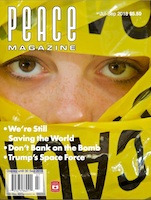
Peace Magazine July-September 2018, page 2. Some rights reserved.
Yemen is facing the world’s worst humanitarian crisis. The conflict, and the Saudi-led attacks that began in 2015, have their roots in the political instability in Yemen. More than 100,000 have been killed since 2015 (and numbers are increasing). To outsiders, the conflict seems to be between Saudi Arabia (and its allies) and the Houthi rebels. However, Saudi-led coalition air strikes were, and are still, the leading cause of the overall civilian causalities.
Ahmed Jahaf, a Yemeni journalist based in Sana’a, joined us in Peace Magazine’s live-streamed “Talk about Saving the World” discussion on Yemen. In the discussion we highlighted the roots of the conflict, the humanitarian crisis and the current attacks on Hodei-dah port and city.
According to official reports, Saudi Arabia and the United Arab Emirates launched their assault on Hodeidah city, by the Red Sea, on June 12. The attacks continue until today, as this article is written. The Saudi-led coalition wants to take control over the city and weaken the Houthi movement, claiming that this would cut a key supply line for the group. A research by Amnesty International confirmed that the Saudi-led coalition has been restricting commercial imports to the Red Sea ports for months, despite announcing in November 2017 that it had lifted the blockade.
There are approximately 600,000 civilians who live around Hodeidah. Prior to the recent Saudi-led attacks targeting Hodeidah port, UN warned that 250,000 might lose everything, including their lives.
Jahaf mentioned that the attacks on Hodeidah would not only affect people in that area, but also most Yemenis who depend on imports and aid through the port. Human rights groups, and the UN, warn that the assault on Hodeidah means a crisis for all in Yemen.
The United Nations fears that the escalation of the conflict in Hodeidah will worsen what is already the world’s most urgent humanitarian crisis, with 22 million Yemenis dependent on aid and an estimated 8.4 million believed to be on the verge of starvation.
Report by Yusur Al-Bahrani and Ahmed Jahaf.
As he had threatened, US President Donald Trump withdrw from the Iran nuclear deal on May 8, renewing sanctions on Iran. Both Europe and Iran, however, promised to continue the Joint Comprehensive Plan of Action (JCPOA) for now.
Iranian President Hassan Rouhani said:“If necessary, we can begin our [uranium] enrichment without any limitations. We will wait for some weeks and talk with our allies and other signatories of the nuclear deal, who will remain loyal to it. Everything depends on our national interests.” This statement implied that Iran will leave the JCPOA if Europe cannot deliver relief from the US sanctions.
And the European Commission is trying to sustain the agreement. On May 17, the body agreed to consider a new version of a statute they had previously used in the 1990s to defend against US sanctions on trading with Cuba. However, not all enterprises can afford to depend on the Europeans’ support. For example, major foreign companies may be cut off from the US banking system if they do not adhere to the US sanctions. Indeed, large multinational companies that depend on US trade will probably have to wind up their business in Iran. However, smaller firms may continue doing business with Iran. The EU is going to enable the European Investment Bank to support investments in Iran. This, and support from China, Russia, and other states, will probably keep the US from being able to force Iran to re-enter negotiations.
On June 6, the IAEA released its quarterly report on Iran’s nuclear program. It bears out what Iranian officials had promised: that their country would remain within the JCPOA. However, the report complained that Iran’s cooperation could have been more timely. Perhaps its rulers were already intentionally dragging their feet, anticipating the US action.
The IAEA report’s generally favorable report on Iran had been finalized on May 24 but released publicly on June 6, the same day that Ali Akbar Salehi, the head of Iran’s Atomic Energy Organization, opened a new facility for centrifuge production which had not been mentioned in the report. While that facility does not violate the deal, so long as Iran observes its safeguard obligations, the decision to open it indicates that Iran is, as it warned, “preparing for a possible scenario” in which it will increase its capacity for enriching uranium even further.
Source: Kelsey Davenport, Arms Control NOW, June 8, 2018.